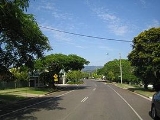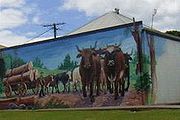
Woombye, Queensland
Encyclopedia
Woombye is a town located on the Sunshine Coast
hinterland in Queensland
, Australia
, approximately 100 km north of the Brisbane CBD
. The name is derived from words from the local Aboriginal language - a place (wumbai) of black snake or (wambai) black myrtle or axe handle made from black myrtle. Woombye has a population of 2,094, as measured in the 2006 census.
 The small township of Woombye is surrounded by what were once pineapple farms, which today are acreage properties and gated communities. Woombye is home to one of the longest established soccer clubs on the Sunshine Coast
The small township of Woombye is surrounded by what were once pineapple farms, which today are acreage properties and gated communities. Woombye is home to one of the longest established soccer clubs on the Sunshine Coast
, the Woombye Snakes. Woombye is also the location of an Australian tourist icon The Big Pineapple
.
Woombye is accessible by Translink
trains and buses. The town is centered around its railway station on the North Coast railway line
with numerous rail services departing for Brisbane daily.
in 1867, the Government built a road connecting Brisbane to Gympie. It was completed in October 1868 and by November, Cobb & Co coaches were carrying passengers, mail, goods and gold between Brisbane and Gympie. Ten staging depots were established along the route, where horses and fodder were kept. One of these depots was 'Middle Camp', half way between Brisbane and Gympie. Here Cobb & Co built the only accommodation for passengers along its route, and the inn and its surrounding buildings soon became known as Cobb's Camp Hotel.
In 1877, Karl Stumpf was granted a licence to sell liquor there. In 1880 the Brisbane to Gympie Road had become almost untrafficable and the alluvial gold in Gympie was almost played out, so Cobb & Co withdrew their coach services.
In 1881, Frederick Schubert took charge of the hotel, and purchased 160 acre (0.6474976 km²) of land, which included all Cobb & Co's land and buildings and is the area on which the township of Woombye now stands. He built a store and a butcher's shop.
In the 1880s, the Court House was built near the police station. The existing name "Cobb's Camp" was considered unsuitable by the Government as there were already many places of that name. So the name Woombye was chosen, after the myrtle tree which grew locally.
The town was surveyed in 1890 and in 1891 the railway from Landsborough
to Yandina
was opened. From 1891 to 1914, Woombye became the rail centre to which Buderim farmers carted all their fruit and produce to rail to the markets, until the Buderim tramway connected Buderim and Palmwoods
.
In 1894, Woombye State School was erected to replace the provisional school.
In 1895, Thomas Bartholomew built a sawmill near the railway yards and it operated until 1965. Equally important, in 1895, Thomas Davey grew the first pineapples commercially in Woombye. Other growers quickly followed him and by 1903, there were 120 acre (0.4856232 km²) of pineapples in the district.
In 1897, Thomas McClintock set up a blacksmith's shop in the police stables after the staff had been transferred to Nambour. In 1898, the Church of England
church and the first Woombye School of Arts building were erected. Also John Tytherleigh established a branch store in Woombye, which operated until 1965.
In 1900, the Methodist church was built, Louis Willersdorf built the first bakery in Woombye. Frederick Schubert built the Criterion Hotel on the corner above the railway yards where it still stands, and the Maroochy Pastoral, Agricultural, Horticultural and Industrial Society was formed and the first Show was held in Woombye on 3 June 1900.
Sunshine Coast, Queensland
The Sunshine Coast is an urban area in South East Queensland, north of the state capital of Brisbane on the Pacific Ocean coastline. Although it does not have a central business district, by population it ranks as the 10th largest metropolis in Australia and the third largest in...
hinterland in Queensland
Queensland
Queensland is a state of Australia, occupying the north-eastern section of the mainland continent. It is bordered by the Northern Territory, South Australia and New South Wales to the west, south-west and south respectively. To the east, Queensland is bordered by the Coral Sea and Pacific Ocean...
, Australia
Australia
Australia , officially the Commonwealth of Australia, is a country in the Southern Hemisphere comprising the mainland of the Australian continent, the island of Tasmania, and numerous smaller islands in the Indian and Pacific Oceans. It is the world's sixth-largest country by total area...
, approximately 100 km north of the Brisbane CBD
Brisbane central business district
The Brisbane central business district , sometimes referred to as the city, is a suburb of Brisbane, Queensland, Australia and is located on a point on the northern bank of the Brisbane River. The triangular shaped area is bounded by the Brisbane River to the east, south and west...
. The name is derived from words from the local Aboriginal language - a place (wumbai) of black snake or (wambai) black myrtle or axe handle made from black myrtle. Woombye has a population of 2,094, as measured in the 2006 census.

Sunshine Coast Football
Sunshine Coast Football is the governing body of football on Sunshine Coast, Queensland. It is a member zone of Football Queensland and Football Federation Australia.-History:...
, the Woombye Snakes. Woombye is also the location of an Australian tourist icon The Big Pineapple
The Big Pineapple
The Big Pineapple is a tourist attraction and working farm situated at Woombye near Nambour, Queensland. The Big Pineapple is 16 metre high and was originally opened on the 15 of August 1971...
.
Woombye is accessible by Translink
TransLink (South East Queensland)
The TransLink Transit Authority is the authority introduced by the Queensland Government in June 2003 as a section of Queensland Transport to coordinate and integrate rail, bus and ferry services. TransLink works with Airtrain, Brisbane Transport, Brisbane Ferries, QR Citytrain and 17 other...
trains and buses. The town is centered around its railway station on the North Coast railway line
North Coast railway line, Queensland
The North Coast railway line is a narrow gauge railway line in Queensland, Australia. It runs from Brisbane, along the Queensland coast to Cairns in Far North Queensland. The line is electrified between Brisbane and Rockhampton...
with numerous rail services departing for Brisbane daily.
History of early settlement
Following the discovery of gold at GympieGympie
Gympie may refer to:* Gympie, a city in Queensland, Australia** Gympie Airport** Electoral district of Gympie** Gympie Region, its local government authority* Gympie Gympie , a stinging plant...
in 1867, the Government built a road connecting Brisbane to Gympie. It was completed in October 1868 and by November, Cobb & Co coaches were carrying passengers, mail, goods and gold between Brisbane and Gympie. Ten staging depots were established along the route, where horses and fodder were kept. One of these depots was 'Middle Camp', half way between Brisbane and Gympie. Here Cobb & Co built the only accommodation for passengers along its route, and the inn and its surrounding buildings soon became known as Cobb's Camp Hotel.
In 1877, Karl Stumpf was granted a licence to sell liquor there. In 1880 the Brisbane to Gympie Road had become almost untrafficable and the alluvial gold in Gympie was almost played out, so Cobb & Co withdrew their coach services.
In 1881, Frederick Schubert took charge of the hotel, and purchased 160 acre (0.6474976 km²) of land, which included all Cobb & Co's land and buildings and is the area on which the township of Woombye now stands. He built a store and a butcher's shop.
In the 1880s, the Court House was built near the police station. The existing name "Cobb's Camp" was considered unsuitable by the Government as there were already many places of that name. So the name Woombye was chosen, after the myrtle tree which grew locally.
The town was surveyed in 1890 and in 1891 the railway from Landsborough
Landsborough, Queensland
Landsborough is a small town on the Sunshine Coast hinterland of Queensland, Australia. It is situated north of the Glasshouse Mountains just off Steve Irwin Way, 82 km north of Brisbane...
to Yandina
Yandina, Queensland
Yandina is a Sunshine Coast hinterland town just off the Bruce Highway. Its name comes from 'yan', meaning "to go", and 'dinna', meaning "feet". At the 2006 census, Yandina had a population of 1,075....
was opened. From 1891 to 1914, Woombye became the rail centre to which Buderim farmers carted all their fruit and produce to rail to the markets, until the Buderim tramway connected Buderim and Palmwoods
Palmwoods, Queensland
Palmwoods is a town in Queensland, Australia, situated near Nambour. At the 2006 census, Palmwoods had a population of 3,576.The small town was previously named 'Merriman Flats' in 1881 by the Kuskopfs who were part of the first White settlers in the area. It was later renamed Palmwoods after the...
.
In 1894, Woombye State School was erected to replace the provisional school.
In 1895, Thomas Bartholomew built a sawmill near the railway yards and it operated until 1965. Equally important, in 1895, Thomas Davey grew the first pineapples commercially in Woombye. Other growers quickly followed him and by 1903, there were 120 acre (0.4856232 km²) of pineapples in the district.
In 1897, Thomas McClintock set up a blacksmith's shop in the police stables after the staff had been transferred to Nambour. In 1898, the Church of England
Church of England
The Church of England is the officially established Christian church in England and the Mother Church of the worldwide Anglican Communion. The church considers itself within the tradition of Western Christianity and dates its formal establishment principally to the mission to England by St...
church and the first Woombye School of Arts building were erected. Also John Tytherleigh established a branch store in Woombye, which operated until 1965.
In 1900, the Methodist church was built, Louis Willersdorf built the first bakery in Woombye. Frederick Schubert built the Criterion Hotel on the corner above the railway yards where it still stands, and the Maroochy Pastoral, Agricultural, Horticultural and Industrial Society was formed and the first Show was held in Woombye on 3 June 1900.

